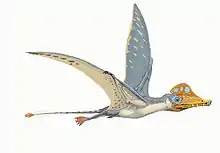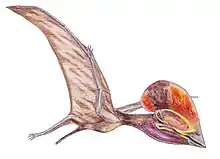Huaxiadraco
Huaxiadraco (meaning "Hua Xia [China] dragon") is a genus of tapejarid pterodactyloid pterosaur from the Aptian-age Lower Cretaceous Jiufotang Formation of Chaoyang, Liaoning, China. It is the third valid genus of tapejarid from the Jehol Biota, after Sinopterus and Eopteranodon. It contains one species, Huaxiadraco corollatus, originally assigned to the defunct genus Huaxiapterus.[1]
| Huaxiadraco Temporal range: Early Cretaceous, | |
|---|---|
 | |
| Holotype specimen | |
| Scientific classification | |
| Domain: | Eukaryota |
| Kingdom: | Animalia |
| Phylum: | Chordata |
| Order: | †Pterosauria |
| Suborder: | †Pterodactyloidea |
| Family: | †Tapejaridae |
| Subfamily: | †Sinopterinae |
| Genus: | †Huaxiadraco Pêgas et al., 2023 |
| Type species | |
| †Huaxiapterus corollatus Lü et al., 2006 | |
| Synonyms | |
| |
History of discovery

Huaxiadraco is based on the holotype ZMNH M8131, a nearly complete skeleton. It was originally assigned to the genus Huaxiapterus by Lü Junchang and colleagues in 2006, under the binomial name Huaxiapterus corollatus.[2] Lü et al. also named another species, Huaxiapterus benxiensis, a year later.[3] However, analyses have since found that these species are only distantly related to Huaxiapterus jii,[4] the type species of Huaxiapterus, and thus require a new genus name.[5] A 2023 review of Chinese tapejarids by Pêgas et al. have confirmed these analyses, finding most of them (including Huaxipterus jii) to belong to the coeval Sinopterus dongi, although corollatus was found to belong to a distinct genus. They thus created Huaxiadraco for corollatus, synonymized benxiensis with it, and referred specimens D2525 (previously considered Sinopterus), BMPC 103, 104, and 105 to it.[1]
Classification
The cladogram below follows the 2014 analysis by Brian Andres and colleagues, showing the placement of the three species assigned to Huaxiapterus. within the clade Tapejaromorpha.[4]
| Tapejaromorpha |
| ||||||||||||||||||||||||||||||||||||||||||||||||||||||||||||||||||||||||
In 2019, a different analysis, this time by Alexander Kellner and colleagues, had recovered the "Huaxiapterus" benxiensis and "Huaxiapterus" corollatus in a more derived position within the Tapejarinae, sister taxon to both Eopteranodon and Sinopterus.[6] The cladogram of their analysis is shown below:
| Tapejaromorpha |
| ||||||||||||||||||||||||||||||||||||||||||||||||||||||||||||


In 2023, Pêgas et al. created a new dataset based on their reassessment of Chinese tapejarids. Their cladogram is shown below:[1]
| Tapejaromorpha |
| ||||||||||||||||||||||||||||||||||||||||||||||||||||||||||||||||||||||||||||||
References
- Pêgas, R. V.; Zhoi, X.; Jin, X.; Wang, K.; Ma, W. (2023). "A taxonomic revision of the Sinopterus complex (Pterosauria, Tapejaridae) from the Early Cretaceous Jehol Biota, with the new genus Huaxiadraco". PeerJ. 11. e14829. doi:10.7717/peerj.14829. PMC 9922500.
- Lü, J.; Jin, X.; Unwin, D.M.; Zhao, L.; Azuma, Y.; Ji, Q. (2006). "A new species of Huaxiapterus (Pterosauria: Pterodactyloidea) from the Lower Cretaceous of western Liaoning, China with comments on the systematics of tapejarid pterosaurs". Acta Geologica Sinica. 80 (3): 315–326. doi:10.1111/j.1755-6724.2006.tb00251.x. S2CID 129851866.
- Junchang, Lü; Yubo, Gao; Lida, Xing; Zhixin, Li; Zhenyuan, Sun (2007). "New species of Huaxiapterus from the Early Cretaceous of western Liaoning". Acta Geologica Sinica - English Edition. 81 (5): 683–687. doi:10.1111/j.1755-6724.2007.tb00992.x. S2CID 128877390.
- Andres, B.; Clark, J.; Xu, X. (2014). "The Earliest Pterodactyloid and the Origin of the Group". Current Biology. 24 (9): 1011–6. doi:10.1016/j.cub.2014.03.030. PMID 24768054.
- Pinheiro, F.L.; Fortier, D.C.; Schultz, C.L.; De Andrade, J.A.F.G.; Bantim, R.A.M. (2011). "New information on Tupandactylus imperator, with comments on the relationships of Tapejaridae (Pterosauria)". Acta Palaeontologica Polonica. 56: 567–580. doi:10.4202/app.2010.0057.
- Kellner, Alexander W. A.; Weinschütz, Luiz C.; Holgado, Borja; Bantim, Renan A. M.; Sayão, Juliana M. (19 August 2019). "A new toothless pterosaur (Pterodactyloidea) from Southern Brazil with insights into the paleoecology of a Cretaceous desert". Anais da Academia Brasileira de Ciências. 91 (suppl 2): e20190768. doi:10.1590/0001-3765201920190768. ISSN 0001-3765. PMID 31432888.












